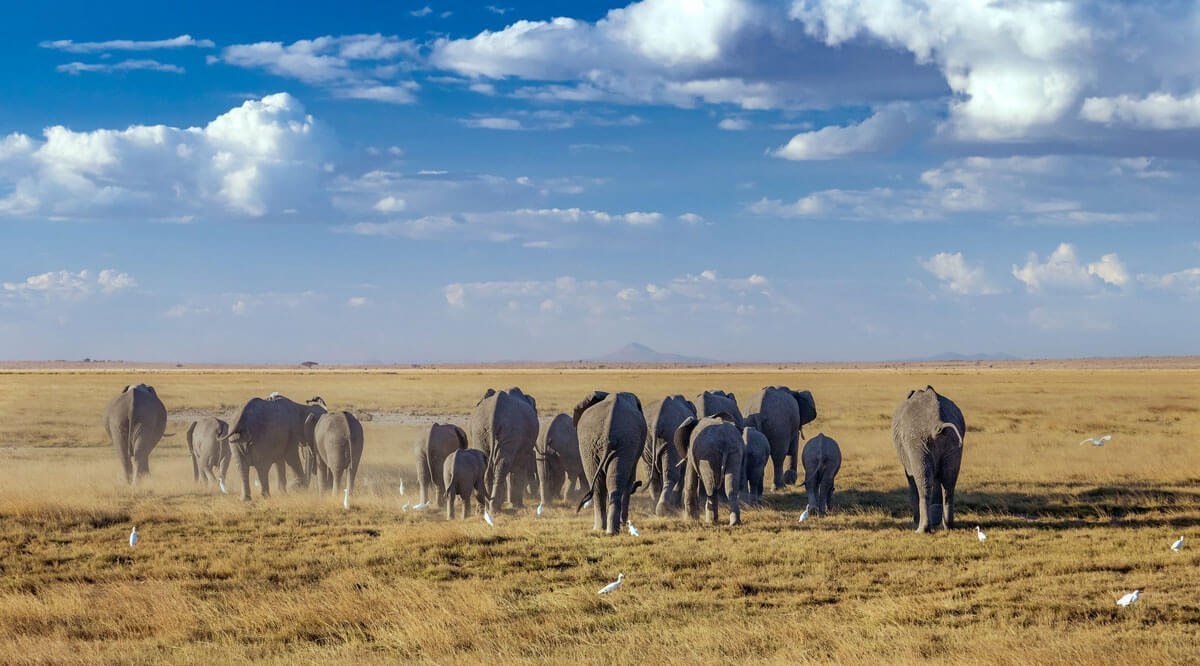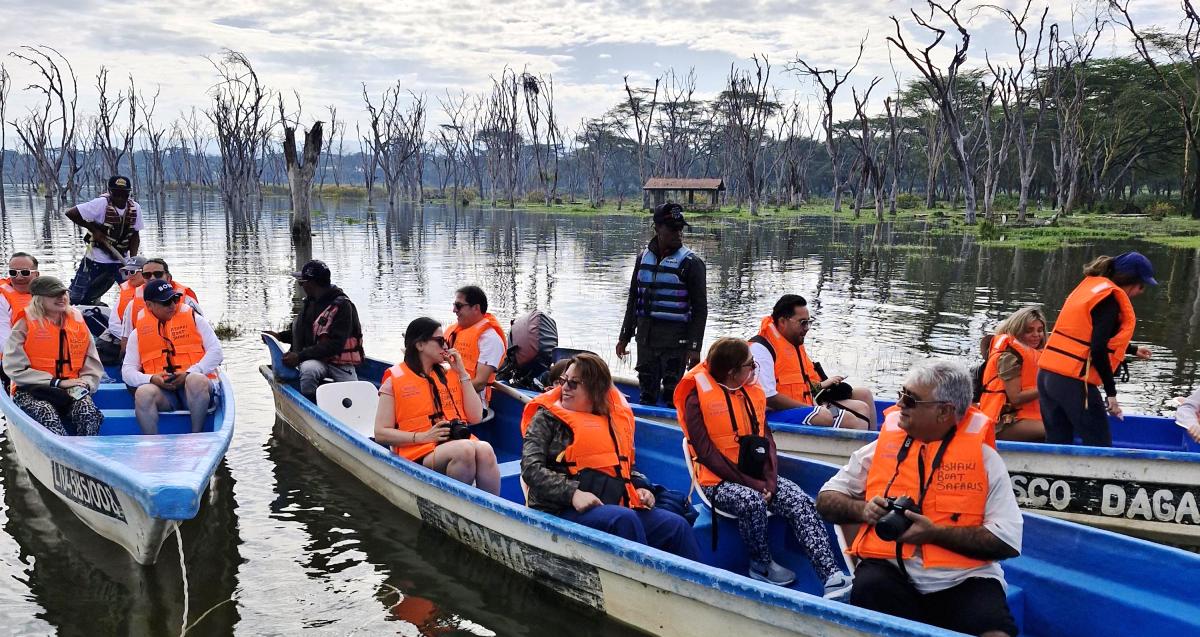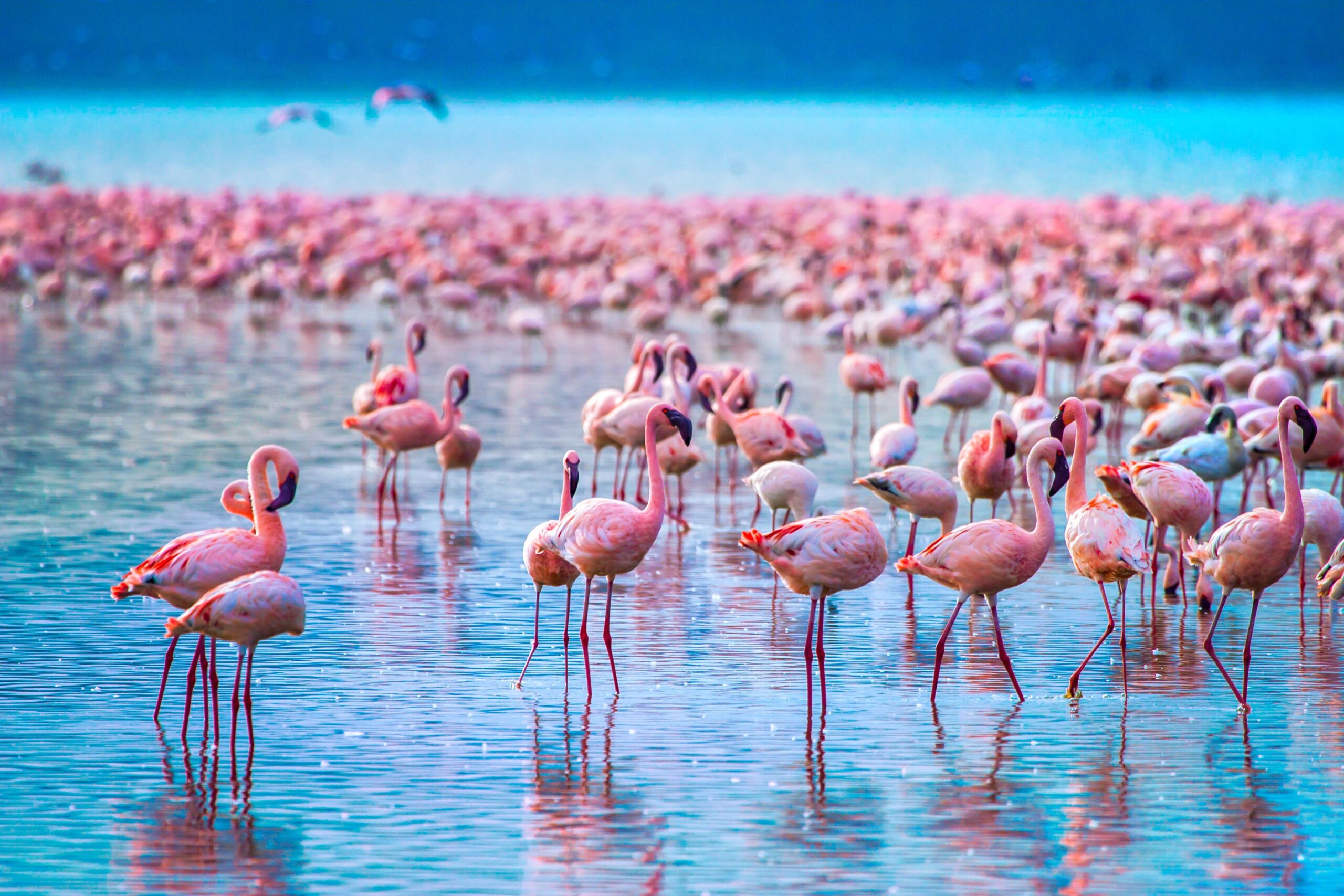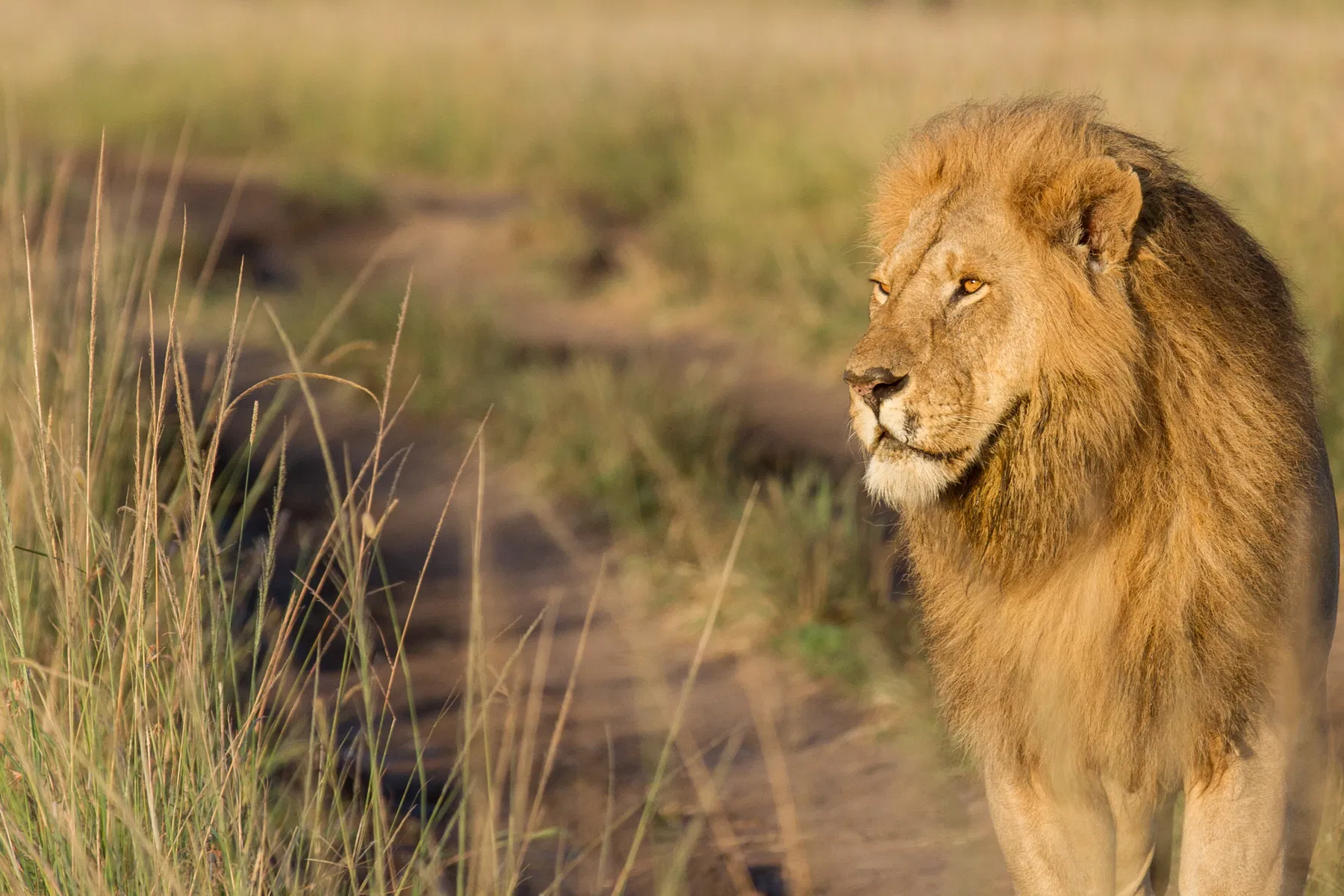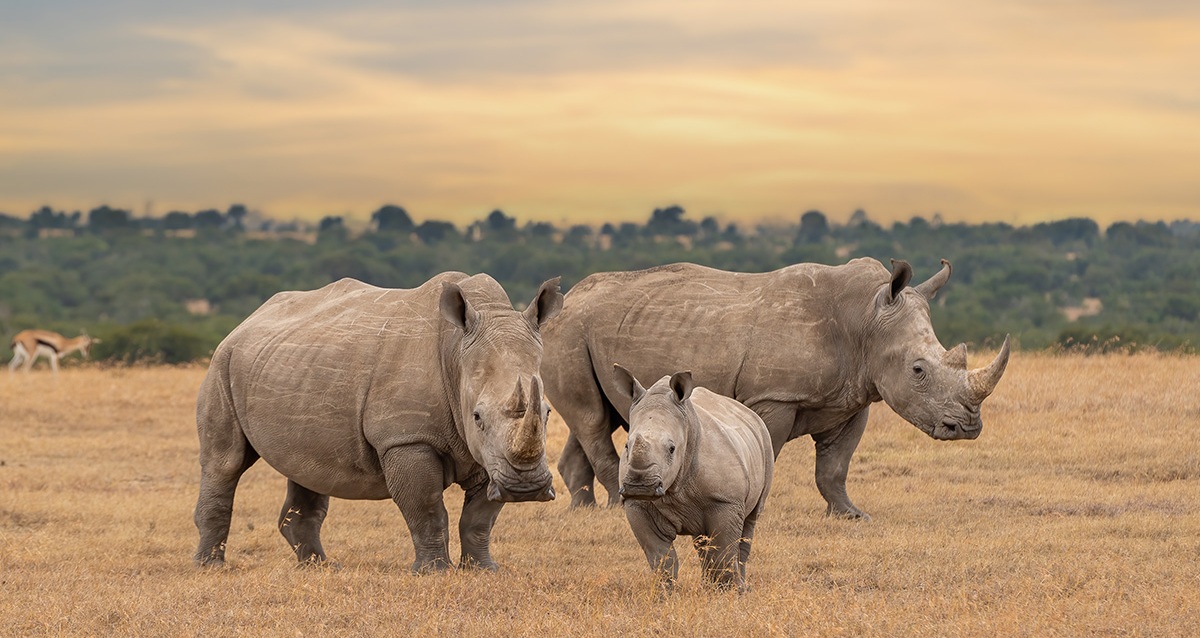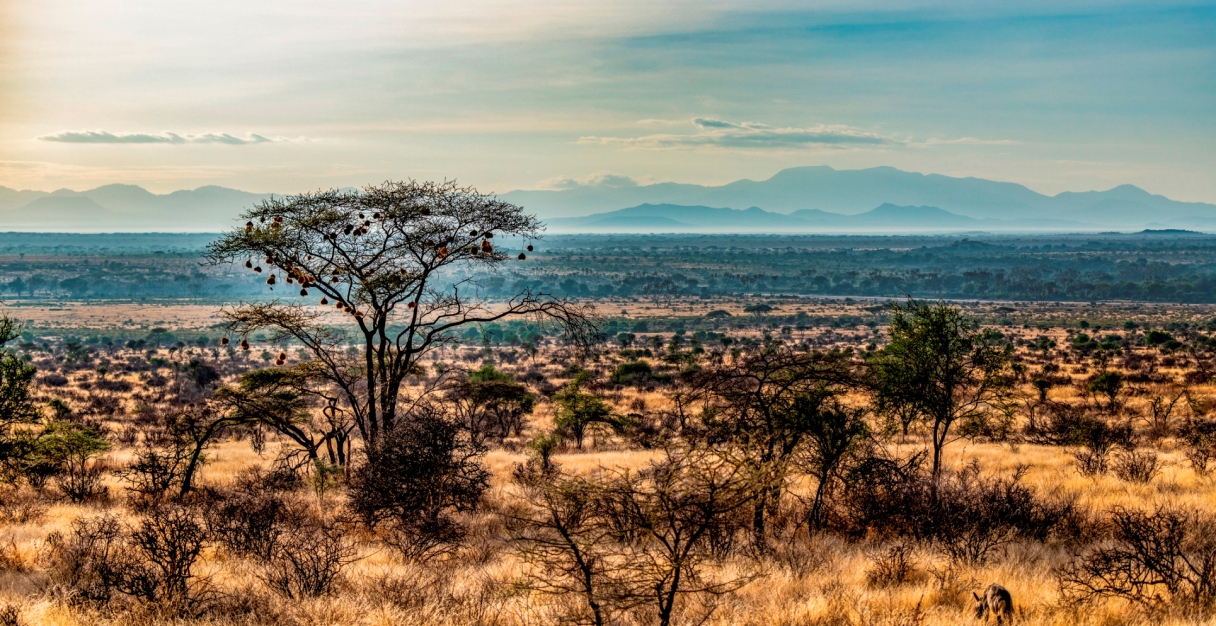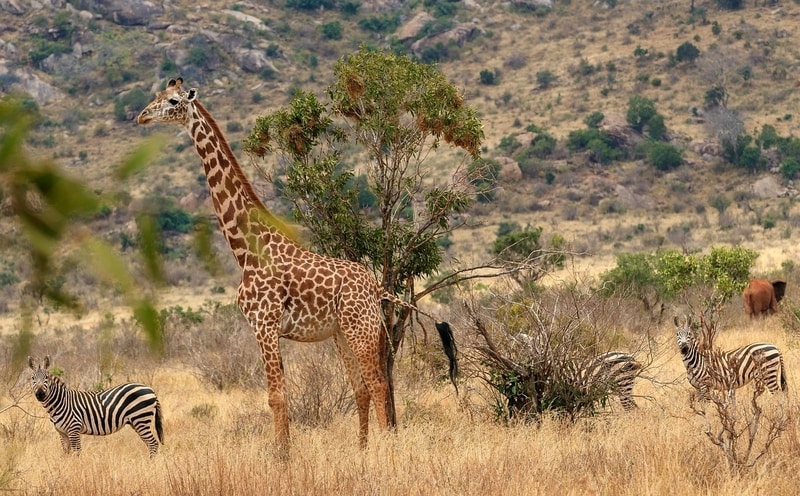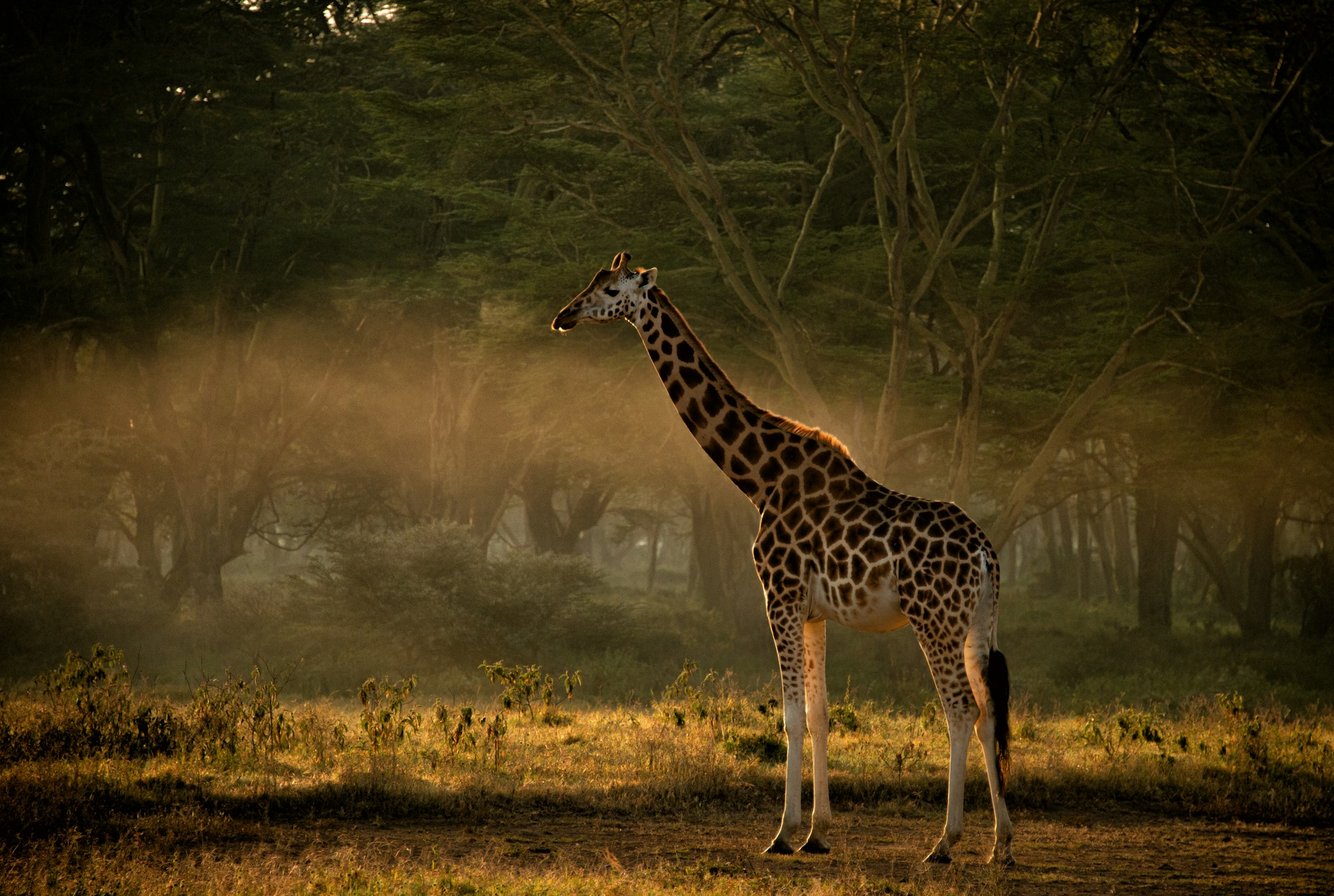And Game Reserves
Kenya National Parks

MASAI MARA RESERVE
Location: South Western Kenya, bordering on the Serengeti in neighbouring Tanazania
History: Originally established in 1948 as a wildlife sanctuary, converted to a Game reserve in 1961. In 1995, the TransMara County Council was formed in the western part of the reserve, and shares control with the existing Narok County Council. In May 2001, the not-for-profit Mara Conservancy took over management of the Mara Triangle.
Area: 1,510 square kilometres (583 sq miles)
Geography/Habitats: The Mara is mostly open flat grassland with long but thin grass and spotted with acacia trees. The Western edge of the Mara is formed by a geological fault throwing up the Esoit Escarpment. Three main rivers drain the area, the Sand, Talek and Mara. It is at the crossing of these rivers that many of the famous images of the great migration are seen
Animals: All of the ‘Big 5’; Lion, Leopard, Elephant, Buffalo and Black Rhino. Wildebeast, Zebra, Gazelle, Topi, Eland, Impala, Giraffe, Hippo’s, crocodiles, hyena, cheetah, jackal, fox, Vulture, Stork, Crane, Ostrich, Eagle, Roller and more.
Of Interest: The most famous events in the Mara revolve around the great migration and especially the river crossings where the migrating animals are concentrated and prayed upon by predators both on land and from the waters. However, Safaris can see a huge array of wildlife at any time of year and indeed enjoy the wild and expansive landscape.
LAKE NAKURU NATIONAL PARK
Location: 140km north-west of Nairobi, in Nakuru district, Rift Valley Province.
History: Nakuru is a Maasai word meaning ‘dust’ or ‘dusty place’. The park was established in 1961 and gazetted in 1968.
Size: The park is approximately 188 km² and in it lies Lake Nakuru one of the soda lakes of the Rift valley that lies 1754m above sea level.
Geography/ Habitat
The Lake covers about a third of the entire park, and in it is the blue green Cyanophyte Spirulina platensis plant, a major food source for the millions of flamingo that reside there. The lake is also bordered by alkalines swamps and marsh at the edges of the blue green waters, with surrounding lower areas of land supporting a savannah like grassland area. The elevated areas are dotted with acacia dry forests and bushland with Rocky Hillsides and scrub on the escarpents and ridges..
Animals: Large numbers of the Greater and Lesser Flamingoes, white and black rhino, buffallo, lion, zebra, gazelle, the rare long-eared leaf-nosed bat, colobus monkey, rock hyrax, hippo, leopard, waterbuck, impala, gazelle, striped hyena, bat-eared fox, wild cat, reedbuck , golden cat, warthog, baboons and over 450 species of terrestrial and water birds.
Of interest: Game drives and great view point picnics in the park such as at the Baboon Cliff View point overlooking the unique diverse landscape.
AMBOSELI NATIONAL PARK
Location: Amboseli National Park is 260km from Nairobi, towards the South West , and on the border with the neighbouring country of Tanzania. It is in Loitoktok District, Rift Valley Province of Kenya.
History: Amboseli was declared a national reserve in 1968. It became a national park in 1974.
Size: Amboseli National Park covers 392km² (151miles²)
Geography/Habitat: With a breathtaking backdrop of Mt Kilimanjaro, the topography of Amboseli comprises of plains, woodlands and rocky thorn bush as well as swamp and marshes. Amboseli has an endless underground water supply filtered through thousands of feet of volcanic rock from Kilimanjaro’s ice cap, that make their way into the heart of the park as two clear water springs and swamps. It also has a dry Pleistocene lake basin that houses a temporary lake, Lake Amboseli, after the rains. However the vegetation is sparse due to prolonged dry seasons.
Animals: Leopard, Cheetah, Wild dogs, Buffalo, Rhino, Elephant, Giraffe, Zebra, Lion, Crocodile, Mongoose, Hyrax, Dik- dik, Lesser Kudu, Porcupine and over 400 bird species.
Of interest: Game drives, bird watching and camping
SAMBURU NATIONAL RESERVE
Location: North Central Kenya close to Isiolo, Shaba and Buffalo Springs.
History: Samburu National Reserve was established in 1948 as part of the enormous Marsabit National Reserve under the national park ordinance. Marsabit National Reserve was gazetted in 1961 and the Senior Game Warden of Samburu District Rodney Elliott suggested to the Samburu County Council that an area north of the river be set aside as a game reserve. It became a reality due to foresight of the County Council and generous assistance given by several individuals and foundations. In 1962, with the financial help from Elsa Trust, Samburu Game Reserve was formed. In January 1963 the Minister for Local Government recommended Samburu National Reserve to be administered by the African District Council of Samburu. It is named after the local people the Samburu who are closely related to the Masai people.
Size: 165 km².
Geography / Habitats: The Samburu National Reserve is located on the banks of the Ewaso Ng’iro river; on the other side of the river is the Buffalo Springs National Reserve in Northern Kenya. It is 165 km² in size and 350 kilometers from Nairobi and ranges in altitude from 800 to 1230m above sea level. Geographically, it is located in Samburu District of the Rift Valley Province. In the middle of the reserve, the Ewaso Ng’iro flows through doum palm groves and thick riverine forests that provides water, without which the game in the reserve could not survive in the arid country.
Animals: Samburu is home to the big five – Elephant, Lion, Rhino, Leopard, Buffalo. Other animals of interest are: Gerenuk, Reticulated Giraffe, Somali Ostrich, Gravy Zebra, Besia Oryx and the endangered Wild Dog and Pun cake Tortoise. It also contains over 450 species of indigenous bird and there are a variety of reptiles and aquatic species in the Waso Nyiro River.
Of interest: A wide range of wildlife, wonderful lodges plus walking safaris and visiting the Samburu people.
Accommodation Options: Lodges, fixed tented camp and camping.
SHABA NATIONAL RESERVE
Location: North Central Kenya close to Isiolo.
History: Established in 1968 Shaba National Reserve is adjacent to Samburu and Buffalo Springs National Reserve. Shaba is smaller with a greater occurrence of riverine forests with acacia trees, doum palms and a dramatic landscape. Shaba took its name from the Mount Shaba (1525 meters), a volcanic mountain that became extinct around 5,000 years ago. Mount Shaba lies on the border of the reserve.
Size: 220 km².
Geography / Habitats: The Game Reserve is semi-desert with a rugged hilly terrain, with great rocky kopjes (small isolated hills) and lots of springs supporting the abundant wildlife. The mountain terrain rises from an otherwise flat area. Shaba Game Reserve was made famous by the late Joy Adamson and is often referred to as the Born free country.
Animals: Shaba is full of klipspringer and hyrax who love the hills. The other animals of interest are the gravy zebra, the Somali ostrich, generuk, reticulated giraffe, gazelles, the lesser kudu leopard, lion and herds of elephants alongside plenty of bird life and other small game.
Of interest: Shaba is quieter than other parks and more for people who enjoy the lifestyle and journey of a safari, rather than rushing around ticking a list.
Accommodation Options: Lodges, hotels, fixed tented camp and camping.
LAKE BARINGO NATIONAL RESERVE
Location: Central Kenya just north of Lake Bogoria.
History: Lake Baringo is named after the local word ‘Mparingo’ meaning Lake. As a fresh water body, Lake Baringo is important to the communities in its basin as a source of water for domestic use and watering livestock consumption. Other important uses are income generation through tourism, biodiversity conservation and fishing.
Size: 130 km².
Geography / Habitats: Lake Baringo is, after Lake Turkana, the most northern of the Great Rift Valley lakes of Kenya, with a surface area of about 130 square kilometres (50 sq mi) and an elevation of about 970 metres (3,180 ft). The lake is fed by several rivers, El Molo, Perkerra and Ol Arabel, and has no obvious outlet; the waters are assumed to seep through lake sediments into the faulted volcanic bedrock. It is one of the two freshwater lakes in the Rift Valley in Kenya, the other being Lake Naivasha. It lies off the beaten track in a hot and dusty setting and over 470 species of birds have been recorded there, occasionally including migrating flamingos
Animals: Lake Baringo has resident hippos, crocodiles and fish eagles. For those with more specialized interests there are also Scops Owl, Barbets, Eagle Owls, African Hoopoe and rare species of bat are just a few of the interesting birds and mammals.
Of interest: Boat trips, nature, wildlife and bird walks
Accommodation Options: Lodges, fixed tented camp and camping.
LAKE BOGORIA NATIONAL RESERVE
Location: Central Kenya just north of the equator.
History: Lake Bogoria is a saline, alkaline lake that lies in a volcanic region south of Lake Baringo and has been a protected National Reserve since November 29, 1973
Size: 700 km².
Geography / Habitats: Lake Bogoria, like Lake Nakuru, Lake Elmenteita, and Lake Magadi further south in the Rift Valley, and Lake Logipi to the north, is home at times to one of the world’s largest populations of lesser flamingoes. Lake Bogoria is shallow (about 10 m depth), and is about 34 km long by 3.5 km wide, with a drainage basin of 700 km².
Animals: Lake Bogoria National Park has herds of rare and handsome greater kudu, as well as buffalo, zebra, impala, dik dik and other small mammals. 135 species of birds have been recorded here and of course thousands upon thousands of flamingo.
Of interest: Local features include the Kesubo Swamp to the north and the Siracho Escarpment to the east, both within the National Reserve. The lake is also famous for geysers and hot springs along the bank of the lake and in the lake. In four locations around the lake at least 10 geysers can be seen, which erupt up to 5 m high.
Accommodation Options: Lodges, fixed tented camp and camping.
HELLS GATE NATIONAL PARK
Location: 90km from Nairobi in the South of Lake Naivasha which is towards the North-West of Nairobi.
History: Established in 1984. It was named Hell’s Gate by explorers Fischer and Thompson back in 1883 after a narrow break in the cliffs that served as a tributary of a prehistoric lake that was a source of nourishment for the early humans in the Rift Valley.
Size: Hell’s Gate National Park covers an area of 68.25 square km.
Geography/Habitats:
The park is dominated by a savannah ecosystem and is famous for its massive cliffs and hot springs. Within Hells Gate is the Hell’s Gate Gorge lined with red cliffs which contain two volcanic plugs: Fischer’s Tower and Central Tower. At specific places there are hot rocks and the odour of sulphur that can be felt in the water. The national park is also home to three geothermal power stations at Olkaria unique to Africa that generates geothermal power underneath Hells Gate from the hot springs and geysers.
Animals: lions, leopards, and cheetahs , Verreaux’s eagles, buffalo, zebra, eland, hartebeest, Thomson’s gazelle, and baboons and over 100 bird species 100 species of birds in the park, including vultures, augur buzzard, and swifts.
Of Interest: Hiking through the scenic gorges, mountain bike cycling round the park, camping, rock climbing, bird watching and wildlife viewing
ABERDARES NATIONAL PARK
History: Established in May 1950 to protect the slopes and moorland of the Aberdare Mountains.
Location: Aberdare is 160km from Nairobi in Central Kenya.
Size: The park covers an area of 767 Km2
Geography/Habitats: The park occupies the elevated areas of the Aberdare Mountain ranges covering an altitude of 1829M to 4001M above sea level hosting the spectacular peaks of Kinangop (3906m/12814 feet) and Ol Donyo Lesatima (3999m/13123 feet).
The topography of the Aberdares is diverse with rugged terrain, deep ravines and many clear streams and waterfalls, v-shaped valleys at higher altitudes and moorland, bamboo forests and rainforests at lower atlitudes. There are red volcanic soils that are rich in organic matter.
Animals: Large population of black rhinos, an endangered species There are also lions, leopards, baboons, balck and white colobus monkeys and over 250 bird species.
Of interest: Game drives, camping, hiking, bird watching, trout fishing and horse riding at designat areas.
MERU NATIONAL PARK
Location: The park is situated in in the Eastern part of Meru, Central Kenya, which is 348km from Nairobi. It is located right on the equator at an altitude of between 1000-3400 feet (304-1036meters).
Size: 870km².
History: The park was established in 1968.
Geography/Habitats: The park is a green paradise compared to the dry savannahs of Kenyan parks, with 15 rivers, numerous mountain fed streams and excellent views of snow-capped Mount Kenya It has diverse scenery from woodlands to wide-open plains, meandering riverbanks, hilly landscapes and rich grey alluvial volcanic soil deposits. Three large rivers border the reserve: the Tana to the south, the Ura to the south-west and the Rojeweru to the east.
Animals: Grevy’s Zebra, Elephants, Eland, Bush Pig, Waterbuck, Cheetah, Leopard, Giraffe, Hippopotamus, Reedbuck, Hartebeest, Python, Puff Udder, Cobra, Buffalo, more than 300 bird species.
Of Interest: game drives, bird watching and camping.
MOUNT KENYA NATIONAL PARK
Location: 150 -175 km North of from Nairobi depending on the route taken. It lies in the Central and Eastern Provinces of Kenya.
History: Established as a park in 1949 to preserve the area’s natural, outstanding beauty. As well as to conserve the animal habitat and protect it as a water catchment area and encourage tourism. Initially it was a forest reserve before being announced as a national park. Currently the national park is within the forest reserve which encircles it. In April 1978 the area was designated a UNESCO Biosphere Reserve. The national park and the forest reserve, combined, became a UNESCO World Heritage Site in 1997.
Size: Mount Kenya National Park covers 715km² and the forest reserve at the base covers a further 705km².
Geography/ Habitats:
Mount Kenya stands a magnificent 5199m (17,057 feet) above sea level, dominating the view for miles around with an eroded crater rim that has formed several peaks surrounded by pristine wilderness, glaciers and mountain lakes. The lower slopes of the park are spectacularly domed with rainforest and dense thickets of bamboo, while higher up the flora changes dramatically: moorland and giant lobelia and heather.
The vegetation can be divided into 3 primary zones as you ascend: the rocky peak area, which is actually an eroded volcanic plug with its mantle of glaciers and snowfields; the alpine zone with its distinctive giant vegetation; and the vast gentle lower slopes drenched in mountain forest and bamboo.
Animals: The majority of animals live lower down on the slopes of Mount Kenya where there is more vegetation and the climate is less extreme. The forests are home to elephant, buffalo, monkeys, antelope and giant forest hog, tree hyrax, white tailed mongoose, mole rat, bushbucks, water buck, monkeys, porcupine and eland. The hyena, leopard and lion are also rare sights. The mountain hyrax and common duiker can be found at higher altitudes.
Of interest: Mountain climbing, wildlife viewing, camping, cave exploration.
LONGONOT NATIONAL PARK
Location: 90km from Nairobi in the Rift Valley Province.
Size: The park is a stretch of 52 km2 mostly occupied by Mt. Longonot.
History: The name Longonot is derived from the Maasai word Oloonong’ot meaning mountains of many spurs or steep ridges. The volcano is dormant and is thought to have last erupted in the 1860s. The park was first opened to the public and visitors in January 1983.
Geography/Habitats: Longonot National Park comprises mainly of a savannah ecosystem with the dominating young volcano – Mt Lononot – that rises to 2,776 metres above sea level. The sides of the mountain are beautiful V-shaped valleys and ridges with little vegetation, but with dense forest occurring within the crater. A trail runs from the park entrance up to the crater rim, and continues in a loop encircling the crater a hiking round tour that takes about 5 hours. On the crater floor is forest vegetation dotted with steam vents around the wall of the crater.
Animals: Buffalos, gazelles, impala and giraffe. Within the thick forest in the crater major wildlife attractions include lion, leopard, bushbucks, common zebra, giraffe, grant gazelles, Thomson gazelles and many other antelopes.
Of Interest: hiking, rock climbing, biking, spectacular views of Lake Naivasha
MOUNT ELGON NATIONAL PARK
Location:
Situated 140 km north-east of Lake Victoria on the Kenya-Uganda border in Trans-Nzoia District, Rift Valley Province. This is 420 kilometres from Nairobi.
History: The Kenyan part of the park was gazetted in 1968 and the Ugandan part in 1992. The park is named after the Mountain – Elgon – which is an extinct volcano with the largest surface area of any extinct volcano in the world (50 by 80 km). The mountain is the 2nd highest in Kenya and the 4th highest in Eastern Africa……( height of mt.)
Size: The park covers an area of 1279 km. The Ugandan part of the park covers 1110km and the Kenyan part covers 169 km.
Geography/Habitat:
Mount Elgon is Kenya’s second highest mountain. Mount Elgon is an important water catchment for the Nona River which flows to Lake Victoria and for the Turkwel River. An ancient, eroded volcano with a huge caldera, its summit has the spectacular flat-topped basalt column known as Koitobos. Another unique feature of the mountain is the lava tube caves, some over 60 metres wide and only caves in the world frequented by elephants (and other animals) digging for salts.
The park is comprised of forest and moorland vegetation. While ascending Mt. Elgon’s enchanting slopes, you will pass through dense montane forest and mixed bamboo belts teeming with birdlife. You will then enter the fascinating heath and moorland zones containing several interesting endemic plant species such as Giant lobelia and groundsels.
Animals:
Elephants and buffalo can be found on the lower slopes. The park is also home to a variety of small antelope and forest monkeys, including the Black-and-white Colobus and Blue Monkey. Over 300 birds can also be found in the area, including the endangered Lammergeier, African Goshawk, and Baglafecht Weaver. Maathai’s Longleg an endangered dragonfly was discovered here in 2000 and named after Nobel Prize winner Wangari Mathaai.
Of Interest: mountain climbing, game viewing, camping, birdwatching, hiking and exploring caves.
TSAVO RESERVE
The Tsavo National Park was gazetted on 1 April, 1948.as Kenya’s 2nd National Park – after Nairobi National Park.
The Tsavo National Park ecosystem covers an area of 20, 812km2 and is the biggest park in Kenya and notably one of the largest game sanctuaries in the world. The park was established in 1948, but later split to Tsavo East and Tsavo West parks for administrative purposes.
The railway line built by the British colonial government then was used as the boundary. Tsavo east was used as a hunting ground for the local communities, the Kamba and Waliangulu. In 1848, the first white man to see Mount Kenya, Dr. Krapf journeyed on foot throughout the park on his way to Kitui, crossing the Tsavo River.
In 1898, construction of the railway river reached the Tsavo River, and at this time the legendary man eating lions of Tsavo killed over 130 railay construction workers until Col. J.H.Patterson stopped the carnage. The British army constructed fortresses along the Tsavo River in the wake of the World War I when Germans from Tanganyika (now Tanzania) threatened to bomb the bridge at River Tsavo in order to dismantle communication.
The Luggards falls is named after a European explorer, Fredrick Luggard who on his way to Uganda made a stop over at the spot where river Athi changes to Galana.
TSAVO WEST NATIONAL PARK
Location: Situated in coast province, on the South Eastern part of Kenya, on the western highway of the Nairobi Mombasa Road, 240 km from Nairobi.
Size: Covers an area of about 9,065 km2 about 30% of the entire Tsavo ecosystem.
Geography/Habitats: Tsavo West is more popular on account of its magnificent scenery, rich and varied wildlife and a good road system. The park’s habitats include open plains alternating with savannah bush and semi desert scrub, acacia woodlands; rocky ridges and outcrops and more extensive ranges and isolated hills; belts of riverine vegetation; palm thickets and on the Chyulu hills, mountain forest. There are numerous rocky outcrops and ridges and part of the park, towards the Chyulu Hills. In the far south-western corner on the Kenya Tanzania border is Lake Jipe, part of which is in the park. There are only two permanent rivers in this vast area, the Tsavo, which begins its life on Mount Kilimanjaro and is greatly supplemented by a huge underground river flowing from Mzima Springs and the Athi in Tsavo East, which begins near Nairobi. Mzima springs are replenished by underground streams that flow from the nearby Chyulu Hills and are a great wildlife attraction. Mzima is also the main source of Mombasa’s water supply.
Animals: leopard, cheetah, buffalo, rhino, red skinned elephant, giraffe, zebra, mongoose, hyrax, dik-dik, lesser Kudu, and Nocturnal Porcupine. There are over 600 bird species.
Of Interest: Game viewing, Camping, Cave exploration, Underwater Hippo and fish watching, Caving at the Shetani caves
TSAVO EAST NATIONAL PARK
Location: Lies on the eastern side of the Nairobi Mombasa road, 240 km from Nairobi, South East Kenya, inland from the Coast.
Size: 13,747 km2
Geography/Habitats:
The park is more arid than its Eastern counterpart, with arid bush and rock outcrops, such as the Mudanda Rock outcrop, 1.6 km long. The spectacular Yatta plateau, about 290 km long spills its lava flows into this park. A series of rapids, popularly known as Lugards Falls on the Galana River meander through the park. The Athi River, that begins from Nairobi, flows through the park.
Animals: The Park is home to most of the larger mammals,the red skinned elephants,rhino, buffalo, lion, leopard, hippo, crocodile, waterbucks, lesser kudu, gerenuk and hirola. There are over 500 bird species in the park.
Of interest: Game viewing, Camping, Trekking, Bird watching
NAIROBI NATIONAL PARK
Size: 117 Km2
History: In the late 19th century, when the British colonialists arrived, many indulged in hunting, in addition to the poaching and local human encroachment and activity that gradually destroyed the park, diminishing animal population. The Maasai lived and grazed their cattle among the wildlife and even as the Nairobi grew, human wildlife conflicts were inevitable. The animals were gradually confined to the south west of Nairobi, of which the colonial government set aside as a game reserve. Mervyn Cowie, a former hunter, proposed the establishment of a National park, in 1932.
In 1933, In 1933, a Royal Commission accepted the project and the “Nairobi Commonage” was formed. From 1933 to 1939, Cowie held public meeting to create awarenesss amongst the people living there. In 1939, a mllitary camp was set out at the West of the park, to capture poachers.
In 1946, the park was officially gazetted , and it became the first national park in Kenya, and in East Africa. Maasai pastoralists had to move from the park. Cowie was appointed as director of the park unti 1996. In 1976, the park was nationalised (K.W.S.) after 30 years of existence as a non governmental organisation. In 1989, the former President Daniel arap Moi burned an ivory stock worth Kshs 60 millions to reinforce Kenyan commitment to fight poaching.
Geography/Habitats: Nairobi National Park is a unique ecosystem by being the only protected area in the world close to a capital city. The vegetation is mainly savannah, with open grass plains and scattered acacia bush. The western side has a highland dry forest and a permanent river with a riverine forest in the south. In addition, there are stretches of broken bush country and deep, rocky valleys and gorges with scrub and long grass. Man-made dams also attract water dependent herbivores during the dry season. The Athi Kapiti Plains are found further south as well as the Kitengela Migration corridor, and there are man made dams within the park that attract animals for replenishment purposes and plenty of bird species.
Animals:
Most of the Big Five: leopard, lion, buffalo and rhino – of the Big 5, only the elephant is absent. Other animals resident include: black rhino, cheetah, hyena, buffalo, zebra, wilderbeest, and eland. There are over 400 species of birdlife at the park. However, all species are not always present and some are seasonal. More recently Nairobi National Park has been designated as a rhino sanctuary and more than 50 rhinos had been moved into the park from remote parts of the country where poaching was rife making the park the most favoured place to see the rhino.
Of interest: Ivory Burning Site Monument; walking trails at hippo pools; Nairobi Safari Walk and the Animal Orphanage; spacious picnic sites and game drives.
KAKAMEGA FOREST NATIONAL PARK
Location: The Reserve is situated in western Kenya, 15 km from Kakamega town, and about 50 km from Kisumu city.
Size: 44km2.
History:
The park, which is found in the vast Kakamega Forest that 240km2, was established to protect and preserve the fragile ecosystem of the only remnant of natural tropical frainforest that once ran from West Africa across Central Africa to to the highland areas on the west and eastern walls of the Great Rift Valley. In 1985, nearly 4400ha of the northern portion of the forest together with the adjacent Kisere Forest were gazetted as Kakamega Forest National Reserve.
Geography/Habitats: The forest is the only remnant in Kenya of the unique Guineo-Congolian forest ecosystem that once spanned the continent. The terrain includes hardwood forest, swamps and rivers, glades and shallow forests around the edges The sheer size and grandeur of these immense trees, some over a hundred years old, is impressive with open areas of grassy glades that have small trees.
The Kakamega region’s vegetation is normally dominated by central African lowland species, but due to its elevation (predominantly between 1500 m and 1600 m) and proximity to the formerly contiguous Nandi Forests it also contains highland elements and is thus unique, whereby half of the park is dominated by indigenous forest. There are about 160 tree and shrub species, many of Congolean lowland forest affinities, including a number of endemic plant species, mostly ferns and orchids.
Animals:
There are over 27 species of snakes. The forest is also home to primates ( the endangered DeBrazza monkey, black and white colobus monkey and vervet monkey) and wildlife such as the Bush Pig, Duikers, Bushbuck, Clawless Otter, Mongoose, Giant Water Shrew, Squirrels, Tree Pangolin, Porcupine. nsects are abundant and some are quite spectacular, such as giant Goliath beetles and numerous colourful butterflies. Lizards and chameleons are also common sightings in the reserve as well as frogs. There are over 300 bird species in the forest.
Of Interest: Forest nature walks, camping, hiking, bird watching, butterfly watching, game watching and camping.
SWEETWATERS PRIVATE GAME RESERVE
Location: Situated between the foot hills of the Aberdares and the magnificent snowcapped Mount Kenya. Only 250km (2.5 hr drive) from Nairobi, the reserve is the closest to Kenya’s capital, Nairobi. The reserve is private, and easily accessible with the highest ratio of game-to-geographical-area of all parks and reserves in Kenya.
Size: 100km2
Geography/Habitats: Open savannah grasslands dotted with acacia bush.
Animals: Big 5″ game – Lion, Leopard, Rhino, Elephant and Buffalo as well as the homson’s gazelle, black-back jackals, ostrich, grant’s gazelle, baboons, waterbuck, oryx, eland and several hundred bird species. You will also find Morani the rhino and Carol the tamed warthog. The reserve is also host to over 20 chimpanzees at a 200 acre piece of land dedicated to them.
Of Interest: Being a private reserve, guests can enjoy special activities not permitted in most Kenyan National Parks and Reserves such as game walks, night game drives, horseback & camel game rides and meals in the bush.
MOMBASA MARINE NATIONAL PARK AND RESERVE
Location: South East Kenya just off the shores of Mombasa.
History: It was established as a Marine Park in 1986, and encloses part of the lagoon, back reef and reef crest habitats of the Bamburi-Nyali fringing reef.
Size: The park is 10 km² while the reserve is 200 km².
Geography / Habitats: The Kenyan Coast is humid with average annual temperatures ranging from 22-34 C. Rainfall is about 500mm pa. The climatic conditions are hot and humid year round. The whole coast line is stunning with white sand beaches and palm trees. The Marine Park helps protect and manage the coastal zone which is home to a large coral reef. The local fishermen catch tuna, shark, squid amongst a host of other fish. Snorkeling the reef is a wonderful experience as you are surrounded by stunning flashes of colour as the fish dart about the crystal clear waters.
Animals: Prolific marine life includes dolphin, crabs, corals, sea urchins, jellyfish, sea stars, and sea cucumbers. Different varieties of coral species comprise of Acropora), Turbinaria and Porites plus a variety of off shore birds can be seen. The reef is home to thousands of vividly coloured fish of all sizes and shapes.
Of interest: Beach, coral gardens, surfing, kite surfing, windsurfing, water skiing, diving, snorkelling, jet skiing, banana boating, sunbathing and sun downers!
Accommodation Options: Lodges, hotels, fixed tented camp and camping
BUFFALO SPRINGS RESERVE
Location: North Central Kenya close to Isiolo, Shaba and Buffalo Springs.
History: Buffalo Springs gets its name from a heart-shaped spring on the west side of the reserve caused by an off-course World War II bomb. The missile that first brought the water is said to have been launched by the Italians, when fighting the British in the area. Yet the pool it created, where before the land was dry, now continuously attracts swimmers and bathers (it’s rumoured to have healing powers), as well as creating a lifeline for a line-up of Kenya’s rare animals. The reserve was established with the aim of protecting the wildlife species found on the riverbanks of Ewaso Ngiro River, which is their main source of livelihood. The Buffalo Springs Reserve, forms part of a large complex of reserves- the other two is Samburu and Shaba. Buffalo and Samburu are adjacent to one another and are only separated by a river. Buffalo Springs is 131 square kilometres and was first opened to visitors in 1985.
Size: 131 km².
Geography / Habitats: Buffalo Springs is less dense and flatter than neighbouring Samburu National Reserve. It’s located on the banks of the Ewaso Ng’iro river; on the other side of the river is the Samburu National Reserve in Northern Kenya. It is 350 kilometers from Nairobi and geographically, it is located in Samburu District of the Rift Valley Province.
Animals: Buffalo Springs is home to the big four (no Rhino) – Elephant, Lion, Leopard, Buffalo. Other animals of interest are: Gerenuk, Reticulated Giraffe, Somali Ostrich, Gravy Zebra, Besia Oryx and the endangered Wild Dog and Pun cake Tortoise. It also has a large number of normal Zebra, which don’t interbreed with the Gravys Zebra. It also contains over 450 species of indigenous bird and there are a variety of reptiles and aquatic species in the River.
Of interest: A wide range of wildlife, wonderful lodges plus walking safaris and visiting the Samburu people.
Accommodation Options: Lodges, fixed tented camp and camping
